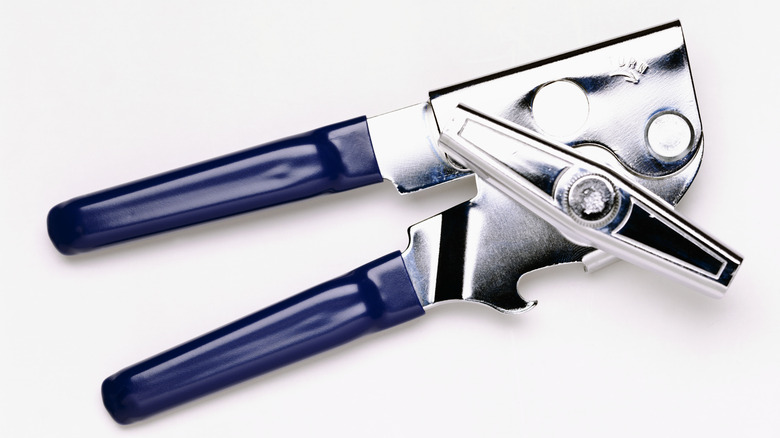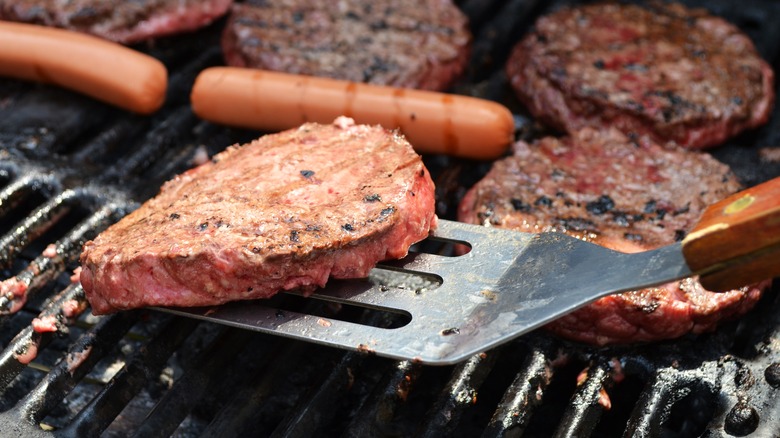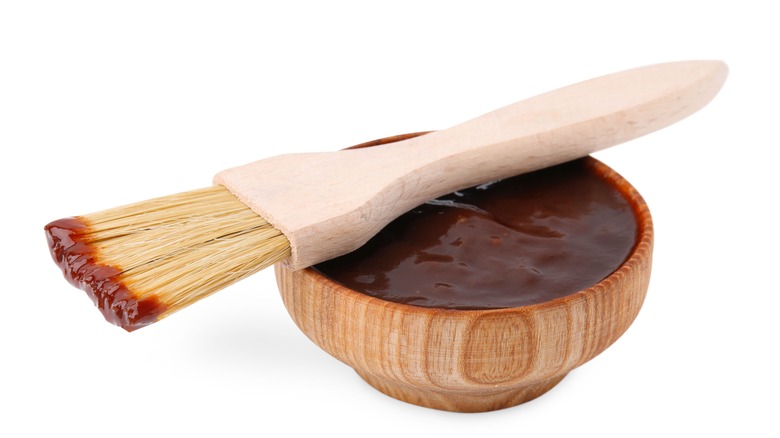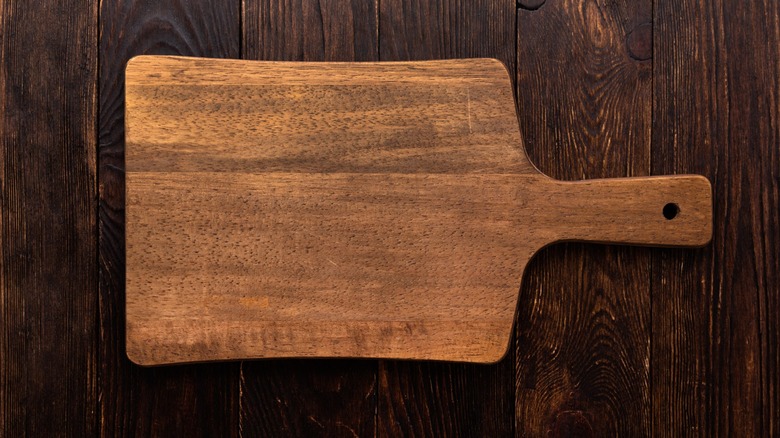12 Signs It's Time To Throw Away Your Cooking Utensils
We may receive a commission on purchases made from links.
There are things in the kitchen you should never reuse – parchment paper and frilled cocktail toothpicks come to mind immediately here — and there are things in the kitchen you should use on repeat until the wheels fall off. It's as much a budgetary consideration as a matter of habit; how easy is it to just keep reaching for the same old kitchen gadgets without noticing how unusable they may have become? Since your utensils live most of their lives in an overloaded drawer or countertop container that looks like a gnarly industrial bouquet, you could be overlooking elements of wear-and-tear that pose health risks ranging from nicks and cuts to mold and bacteria exposure. It's important to know when to give up the ghost and replace that jacked-up potato peeler to minimize the potential for an urgent care visit.
What signs do your most frequently-used utensils give that it's time to toss them out and go shopping for replacements? I gathered up a selection of kitchen doodads that are most likely to send out signals when they've outlived their structural integrity. If you've ever picked bamboo bristles out of your basted ribs or sliced your finger on a jagged lid while wrestling with a wonky can opener, this collection of helpful tips is for you.
1. Your can opener has rusted
A hard and fast rule to adhere to is that anything in your kitchen showing signs of rust should be replaced immediately, an age-old chestnut that applies to your can opener as much as your cookware. Whether you favor the whir-and-grrr of an electric model or the crank-and-yank of a manual hand-held version, the gears of your can opener are exposed to all sorts of liquids and pastes that can settle in without drawing notice. After a while, your gadget's ability to perform its job with dependable accuracy is compromised, and you may find yourself working harder than necessary at what used to be one of the easiest tasks a home chef can undertake — no TikTok hacks necessary.
You might be tempted to de-rust your can opener with a spritz of WD-40, but that would be a mistake. This silicone-based solvent is highly toxic and comes with a "may be fatal if swallowed" warning on its California safety sheet. And if you keep using it without intervention, you may be inadvertently exposing the contents of your canned goods to bits of rust that end up in your finished dish. You're much better off pitching your can opener when you see rust accumulating and shopping for a deluxe new gizmo to get your tinned ingredients opened. Consider it an opportunity to upgrade to a model that makes this simple job even simpler.
2. Your plastic cutting board has surface slashes
Who doesn't love having lightweight plastic cutting boards on hand in a variety of sizes for slicing everything from garnishes for cocktails to elements for gourmet dinners? Some companies even market color-coded plastic cutting boards to prevent cross-contamination between meat and poultry and other non-biologic ingredients. The idea of at-a-glance grabbing of the right cutting board for the job at hand is such clever trickery, it's a wonder that kitchen utensil providers didn't think of it sooner.
But just because it works to keep your food safer doesn't mean you should plan on keeping your plastic cutting boards around forever. The accumulation of deep grooves and slashes in the surface are an indication that bacteria may be building up, making it difficult to ensure a clean cutting board. And as with just about every other plastic item on the planet these days, the dust that may enter your food while using your cutting board for deep slicing can result in your unintentional consumption of microplastics. An easy solution is to toss your cutting boards when you see excessive grooving in their surfaces and replace them with more health- and environmentally-friendly bamboo cutting boards. They come in multi-sized sets that can replicate the visual cues of dedicated boards, and they're BPA- and plastic-free.
3. Your wooden spoon has split
There's something about a wooden kitchen spoon that plastic spoons just can't replicate. Maybe it's the structure or the weight, or the idea that wooden utensils are a sounder option for the environmentally-conscious cook. The affordability factor is also a plus when stocking your kitchen with tools that don't drain your bank account dry.
While wooden spoons are a definite helper in the food prep process, they won't last forever. Exposure to liquids and heat can soften the surface, leading to eventual cracking that splits the bowl of your spoon, resulting in splinters in your food and possible bacteria growth in the wood itself. This goes for wooden spatulas and forks as well. Discoloration may occur during the cooking process, making it difficult to tell if your split spoon is also moldy or just decorated with burn spots from where you left it in the pot too long. Should you see any form of splitting or fraying on your wooden spoon or other utensils, it's time to pitch it in the bin and invest in a shiny new set of wooden utensils, one that lets you reestablish the sheen on your cookware collection.
4. Your spatula head has slid off the handle
Let's face it: One-piece spatulas are the gold standard for kitchen utensils that mix, stir, and fold. Not only do they usually offer stronger handles that let you dig to the bottom of the bowl with confidence, they also have no squirrely parts that come loose with too much pressure. Unlike a one-piece spatula, the less-impressive two-piece spatula design with the plastic handle and silicon paddle becomes a breeding ground for bacteria and a mold farm over time. Once the head slips off the handle, whatever you're whipping up can enter the slot and stay there, no matter how hard you try to dig it out. And since you can't dry it well enough after washing the channel, slipping it back on and stashing it away means you've just created a petri dish in your spatula.
Since a spatula is a key utensil for everything from whipped topping to flaky pie crust, you'll be doing yourself a favor to discard your two-piece spatula once the paddle comes loose. Pick up a one-piece standard silicone spatula set to keep the flexible scoop-and-scrape personality of your old one or spring for a variety of one-piece spatula shapes to use on as many kitchen projects as you can dream up.
5. Your non-stick pan is scratched
The allure of a non-stick pan is too tempting to walk away from. What home cook doesn't feel their heartbeat speed up at the prospect of not having to scrape food off their cookware? This 20th century step-up from the usual metal cookware pieces gave chefs a distinct and welcome advantage when clean-up time rolled around; to this day, it's the easiest way to minimize the labor that comes after the meal is finished and all that's left is a mess in the kitchen. Why would you ever do more work than necessary if you can avoid it?
The prospect of keeping your non-stick pans forever is a pipe dream however, as even modest scratches that are bound to appear on the sides and bottom may be a hazard in the making. Not only does it mean bits of coating may have gotten into your favorite creations, it also exposes the metal beneath to the potential for rust and corrosion, as well as removing the non-stick feature you bought the pan for in the first place. If you start to see signs of stress on the surface of your non-stick pans in the form of scrapes and grooves, be prepared to replace them with new non-stick pans as soon as possible. Check into ceramic-coated cookware instead of Teflon-sprayed metal for an even sturdier version of non-stick cookery.
6. Your veggie peeler has corroded
You may call it a shaver due to its resemblance to an old-fashioned wet razor, but your veggie peeler is really a miniature double-sided blade with a handle that can plane off the outer layer of almost any piece of produce you put before it. It's one of the handiest little tools ever dropped into a kitchen drawer, a stalwart partner in the enterprise of stripping down potatoes, unsheathing apples, and reducing carrots to their most skinless state. But all of that exposure to liquid means your metal blade will eventually show signs of rust and corrosion, which will transfer to your premium picks without you even noticing. That's a recipe for disaster no matter what you're peeling. There's also the possibility of dulling, and sharpening your peeler isn't recommended.
Check both sides of the blade on your peeler for rust, discoloration, or corrosion that could lead to contamination and discard this utensil as soon as you see signs. Then, go shopping for a veggie peeler with a comfort grip and sturdier construction to help extend the life of your utensil. There seem to be new designs appearing regularly, so depending on when you shop, you may be in for an experience similar to picking out a new car. Shop wisely; your produce peeling depends on it!
7. Your flipper handle has come loose
Grill masters grow accustomed to their preferred flippers; the weight and shape help them make the most daunting open-fire cookery look like stunt work. Shifting to a new flipper can alter the calculus to the point of an established grill cook requiring a technique redo to get their bearings, which means holding onto their utensils possibly beyond their recommended lifespan. And when the million-flip point has been reached, there's a distinct possibility the rivets that attach the handle to the flipper will be loose enough to warrant a replacement, even if it means having to refresh your barbecue mojo. Keeping it out of the dishwasher can help extend its existence, but at some point, you may have to face reality: flippers don't last forever.
What happens if you keep using a loose flipper? Beyond the obvious dropping of your premium-priced steaks and burgers into the flames, there's also the potential for losing the handle altogether and dropping the food onto your skin, resulting in grease burns you don't want to go through. Instead of taking unnecessary risks, assess the assembly of your flipper and get ready to flip it into the dumpster when the handle loosens. Then, treat yourself to a snazzy new flipper and take it for a few test runs to get a handle on things before grilling to impress the neighbors.
8. Your basting brush bristles have started to fall out
It happens before you notice ... one minute, you're happily basting ribs with your special sauce or brushing the tops of your famous dinner rolls with egg wash with your natural bristle basting brush, and the next minute, you find stray bristles cluttering your culinary creations. Maybe you can pick them out before your dish hits the grill or the oven, but do you really want to risk your friends and family getting a basting brush bristle in their food? You may not be going for a Michelin star, but you're bound to get a thumbs-down for such a rookie mistake.
Before you reach the point of regret with your cheap bristle-based basting brush, shift to a silicon basting brush, one where the bristles have no choice but to stay attached. Not only will you have trouble-free basting thanks to the genius one-piece design, you'll also be able to use your new utensil on hot foods straight out of the oven without risking burns to the bristles.
9. Your French press strainer mesh has come loose
Few things welcome the morning like a fresh cup of coffee prepared in a French press. The bold flavor is an essence that other brewing methods can't capture, and the fact that you don't need electricity to operate the press means you can enjoy delicious coffee pretty much anywhere. There's also no need for replacing paper filters or throwing away used coffee pods, since your press includes a reusable mesh strainer as a design feature. The assumption is that a sturdily-constructed French press will always be at the ready for your coffee needs, no matter how much you put it through its paces.
But there are errors inherent in the process, and one of the more egregious French press brewing mistakes you can make is letting the mesh around the strainer come loose. This is inevitable with enough use and is bound to let loose grounds drift into the liquid — and into your coffee cup. Unless you like chewing your coffee, be on the lookout for gaps around the edges of the plunger. When the mesh appears to have loosened, or when you notice stray grounds drifting into the chamber above the plunger, pick up a replacement French press plunger to get things back on track. And if you're feeling extra, you can opt for an entirely new French press and gift your old one to a fellow coffee lover, with the caveat that it needs a bit of renovation.
10. Your whisk is losing its silicone coating
A silicone-coated whisk can be a real problem solver, allowing you to pick up every last bit of the good stuff while whipping air into the mix or incorporating your ingredients into culinary conformity. But if your silicone-coated whisk has a run-in with firmer utensils, you may start to see the silicone peeling away from the metal underneath. There's a chance that this metal isn't food safe; substances caught between the wires and the coating can generate bacteria growth. Add to that the chance you take of having someone find pieces of silicone in your finished food, and it's clear that the time to replace your whisk has arrived.
Getting your silicone-coated whisk back in action is as simple as an Amazon click, where sets of whisks exist that let you distribute the work amongst several utensils, extending the life and usability of all pieces. Of course, if your cookware allows it, you could always shift back to the old-fashioned metal balloon whisk that puts the telltale "shick-shick-shick" sound into your cooking endeavors. It's a great way to let the rest of the house know something incredible is about to hit the table and get mouths watering.
11. Your wooden cutting board is chipping
There are few kitchen utensil incidents sadder than seeing a wooden cutting board reach its breaking point. These sturdy slabs seem like an invincible partner in your most frenzied gourmet enterprises, standing by for everything from the rocking chop you give fresh herbs to the pugilistic pounding you deliver to fillets and cutlets. Eventually, you may apply too much pressure, or your board may absorb more moisture than it's meant to take, and you'll see splits or cracks develop. Rather than risking wooden slivers or bacteria build-up entering into your home kitchen food chain, it's time to bid your dependable utensil a fond farewell and begin the search for a replacement.
The good news is you're free to explore the wide world of wooden cutting boards and choose one (or a set) that accommodates your current cooking adventures. Will it be a three-piece collection of thin bamboo boards that stack and store with minimal space taken? Or is an extra-large teak cutting board situation about to enter your cooking life? True that you should never forget old friends who helped you find your way in the kitchen, but you should also be open to partnering with new utensils that can take you to the next level.
12. Your thermometer isn't giving accurate readings
Though there may be a handful of kitchen scenarios in which a food thermometer comes to the rescue, you'll want to make sure this utensil is in tip-top shape when the moment arrives. Having a thermometer that throws out fictitious numbers can result in undercooked food, which can be a disaster for meat- and poultry-based food safety requirements, as well as causing confectionary disasters, which can keep your hard-crack candy at the soft-ball stage and ruin your chances at sweet success. It's best to test your thermometer well ahead of your most necessary occasions and purchase a new one as part of your preparation process.
If you've been hanging onto an older version of this necessary tool, you have a golden opportunity to upgrade to a multi-purpose cooktop thermometer that can cover a whole host of heating needs, everything from frying potatoes to boiling fudge. You'll still need a meat thermometer to ensure your oven-cooked and grilled cuts reach their desired temperatures. Luckily, there's no rule that says you can't have a pair of thermometers to get your kitchen activities heated up just right. In fact, it's what any chef worth their salt would do.












